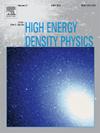修正高斯-邦纳重力对类重力星结构的影响:高能稳定性和电磁效应
IF 0.9
3区 物理与天体物理
Q3 PHYSICS, FLUIDS & PLASMAS
引用次数: 0
摘要
在这项研究中,我们探索了带电、无奇点、圆柱对称的类重力星结构的形成和稳定性,作为f(G,T)重力框架下黑洞的可行替代方案。这里,G表示高斯-博内项,而T表示能量-动量张量的轨迹。我们在三个不同的区域构建解决方案,为每个区域使用适当的状态方程(EoS)来描述它们的物理性质。通过推导度规系数和分析圆柱对称时空中非守恒定律的运动方程,我们研究了电磁场对熵、能量和结构长度的影响。我们的分析与高能天体物理环境的研究有关,如相对论性等离子体结构、非局部热力学平衡(LTE)动力学条件和超致密物体的内部。通过图形研究,我们证明了在高斯-邦纳修正重力的特定参数选择下,圆柱形gravastar-like物体可以在自然界中存在,有助于更广泛地理解极端条件下的物质和辐射相互作用。此外,我们评估了电荷在改变这些致密物体的稳定性条件中的作用。通过对势函数的二阶导数和推导出的约束方程,我们证明了在适当的参数条件下,带电引力星模型比不带电引力星模型具有更强的稳定性。我们的发现提供了对修正重力(如f(G,T)重力)和紧凑带电结构中受电磁效应影响的能量密度分布行为之间相互作用的见解。本文章由计算机程序翻译,如有差异,请以英文原文为准。
Implications of modified Gauss–Bonnet gravity on gravastar-like structures: High-energy stability and electromagnetic effects
In this study, we explore the formation and stability of electrically charged, singularity-free, cylindrically symmetric gravastar-like structures as viable alternatives to black holes in the framework of gravity. Here, represents the Gauss–Bonnet term, while denotes the trace of the energy–momentum tensor. We construct solutions across three distinct regions, employing an appropriate equation of state (EoS) for each to describe their physical properties. By deriving the metric coefficients and analyzing the equations of motion with the non-conservation law in a cylindrically symmetric spacetime, we examine the impact of electromagnetic fields on entropy, energy, and structural length. Our analysis is relevant to the study of high-energy astrophysical environments, such as relativistic plasma structures, non-local thermodynamic equilibrium (LTE) kinetic conditions, and the interiors of ultra-dense objects. Through a graphical investigation, we demonstrate that cylindrical gravastar-like objects can exist in nature under specific parametric choices within Gauss–Bonnet corrected gravity, contributing to the broader understanding of matter and radiation interactions under extreme conditions. Furthermore, we assess the role of charge in modifying the stability conditions of these compact objects. Through the second derivative of the potential function and the derived constraint equation, we establish that charged gravastar models exhibit enhanced stability compared to their uncharged counterparts, provided appropriate parametric conditions are met. Our findings offer insights into the interplay between modified gravity, such as gravity, and the behavior of energy density profiles influenced by electromagnetic effects in compact charged structures.
求助全文
通过发布文献求助,成功后即可免费获取论文全文。
去求助
来源期刊

High Energy Density Physics
PHYSICS, FLUIDS & PLASMAS-
CiteScore
4.20
自引率
6.20%
发文量
13
审稿时长
6-12 weeks
期刊介绍:
High Energy Density Physics is an international journal covering original experimental and related theoretical work studying the physics of matter and radiation under extreme conditions. ''High energy density'' is understood to be an energy density exceeding about 1011 J/m3. The editors and the publisher are committed to provide this fast-growing community with a dedicated high quality channel to distribute their original findings.
Papers suitable for publication in this journal cover topics in both the warm and hot dense matter regimes, such as laboratory studies relevant to non-LTE kinetics at extreme conditions, planetary interiors, astrophysical phenomena, inertial fusion and includes studies of, for example, material properties and both stable and unstable hydrodynamics. Developments in associated theoretical areas, for example the modelling of strongly coupled, partially degenerate and relativistic plasmas, are also covered.
 求助内容:
求助内容: 应助结果提醒方式:
应助结果提醒方式:


